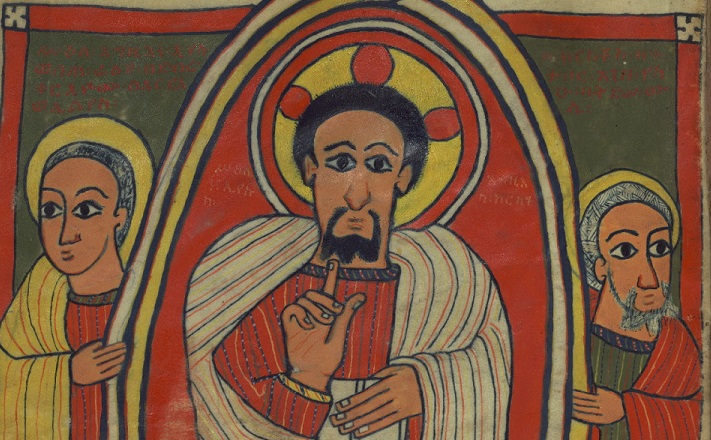Commentary on Luke 9:28-36 [37-43]
Today we have two lectionary texts that apparently don’t go together.
Some commentators even say that the preacher needs to choose one or the other. However, I think they must go together.
Here we have Jesus at the top of the mountain being transfigured, receiving the visits of Moses and Elijah and they are talking about Jesus’ departure. They were celebrating the Feast of Booths or Tabernacles where people celebrated the protection offered by God during their wanderings in the wilderness (Leviticus 23:39-43). Moses and Elijah have been interpreted as the law and prophecy, now reunited with the Messiah. When the disciples see this gathering they want to build a booth for each so they can stay with them but Jesus says they need to go back to the people. Elijah and Moses disappear into a cloud that overshadows them. From this cloud appears a voice from God saying who Jesus is and that the disciples are to listen to him.
For the rational mind this is a very strange text, because it is about transfigurations, people who didn’t die reappearing, and a voice coming from a cloud. If you have ever read anything from Gabriel Garcia Marques, Jorge Luis Borges, Isabel Allende or Laura Esquivel, among others, you know that this transfiguration text can easily be counted among the Latin American magical realism literature.
Magical realism is about different levels of reality working at the same time. The binary realms of the real/unreal do make sense since the real happens in the fictional but the fictional is real. The natural must be counted by the supernatural and the fantastic is just a true presence as a three in the way. The stories with people of all kinds, ghosts, and other presences are ways that figure, disfigure, unfigure, and transfigure our realities.
Thus the transfiguration story is a real-magical story that has tremendous theological realities and social consequences. Let me name just a few. First, the apparent trinity at the top of the mountain is wrapped up in glory! A glory that is shared, that illuminates each other, that strengthens each other’s lives, and gives meaning to the past and future events. Second, when they disappear they disappear into a shadow, a cloud, and from that cloud comes the voice of God affirming Jesus. Third, the transfiguration of Jesus is a metamorphoses (“transfigured” in Greek: metamorphothe), a transfiguration, a radical change and shift, an event that transforms those who go through it. This transfiguration does not serve only Jesus but prepares him to go back to the people and continue his ministry until his departure. Fourth, before the sacred, we also learn to keep in silence.
One of the lessons of this text is that the glory of God is only possible if lived together, in community. Nobody, not even Jesus, could shine alone! The work of that trinity shows that only when we are together that God’s radiance can light each other’s lives. Also, we can only make sense of ourselves if the people who came before us are presence in our struggle. Our ancestors come to us to give us a thick sense of the present and to say that they survived under the name of God and we can do that too. Glory is only possible if shared and that means that we are to share the light of Christ to the world, especially those placed in the shadows of our society. This is related to the second theological point that the shadow, in which they disappear into, carries the voice of God affirming Jesus. In that way, when we light the lives of those placed in the shadows of society, we must know that it is from those shadows, from those clouds that the voice of God appears, affirming Jesus! Third, this metamorphoses directs Jesus back into his mission. While the disciples wanted to hang out there amidst those giants of faith and basking in the glory and transfiguration of Jesus, they were demanded to go back to their lives. However, in between the transfiguration and the noisy streets of our lives, we keep in silence trying to figure out the transfigured Jesus, knowing that we are part of this transfiguration and that means that God will refigure our lives, our thinking, our actions our path. When we meet the transfigured Jesus we are disfigured, transfigured, and refigured.
At this juncture we can understand why this text needs the following text that talks about the miracle of healing of this disgraced boy. This boy is in psychological and social chains; the demons have taken hold of his life. There is way too much realism in his magical life, so Jesus has to intervene! The disciples were not transfigured enough to deal with it and the transfiguration of Jesus shows that Jesus has little patience with their lack of power, their lack of understanding/figuring out who he is and what message he has to offer. Thus, Jesus’ indictment of the faith of the disciples “‘You faithless and perverse generation,” sounds true to us as disciples of Jesus today. Our world is dashing the poor against the rocks of despair, hunger, and abandonment everyday. The economic beast controlled by few demons is making our people convulse day and night. The homeless, the immigrant, the incarcerated, those mothers who work three jobs to make a minimum wage to feed three, four kids, they are like that boy, thrown into the shadows of our society, convulsing day and night right in front of us! And we, who seem to not know anything about the transfiguration of Jesus or our own transfiguration (metamorphoses) are looking at these people while asking Jesus: can we dwell in our worship tabernacles basking in your glory, away from the people and their pressing needs?
Unless we get out of the fortress of our worship spaces, and rebuke the unclean spirits of the powers that be, and shed light into the lives of the poor of our communities, we will never know what transfiguration means. Glory will be an unknown word and experience. We can have a sound theology and say that in that passage, Jesus is the point of beginning and end, the past and the future giving weight to our present, the conciliation of opposite poles, the connection between the shadow and the light of God, the incarnation of the most divine glory. However, if in the name and by the grace of God we cannot heal the boys and girls of our own people and give them back to their parents we will never know what transfiguration means, what shared glory looks like and we will never be “astounded at the greatness of God.”


February 7, 2016